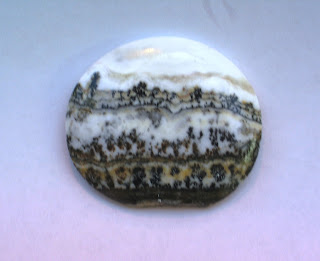If
you Google “story stones” you’ll be pointed to web sites where people have
painted or otherwise added something to a rock in order to give it an element
of interest and possibly make it an element of storytelling and sharing.
Not me.
My story stones already
come with wonderful stories in them and the only thing I need to do to reveal
the story, is to remove the excess rock, shape, and polish. Admit it; you’ve
done the same thing. You look at a rock or a slab and say to yourself, ‘that
looks just like a _____!’ Then your job comes down to using your lapidary
skills to make it apparent to everyone else.
SHAPE IS PART OF THE STORY
I
often find that a stone can tell its story within the constraints of the shapes
available on lapidary templates, but not always. Sometimes you have to listen
to how the stone tells its story best. For example, in “Prayer” below, I did it
free-form because I felt the capsule around the praying figure would highlight
it best if it
followed the lines of the figure.
I found this little beauty
(it’s much smaller than it looks in the image) in a discard pile! It’s a beautiful quartz that took a high polish and
I’m planning to have it made into a ring someday.
 |
Prayer |
PATTERN CAN TELL THE STORY
In this chatty silver lace opal, you can see the tree-lined, muddy river at the bottom and the vineyard higher up alone with a cloudy sky. Or at least that’s what I saw in the slab. It was originally part of a long almost ribbon-like slab and I made an oval cabochon to give it an old-fashioned look. What do you see?
This one I call the “Knee Bone”.
The “marrow” part is a shiny jasper/quartz and the
“calcified” part on the outside of the bone is, I believe, common opal. Notice
how it flares out at the top and there’s even a little notch where it would fit
with the bone above!
Have you worked on
stones that insisted they had a story for you to bring out in them? I’d love to
hear about it! Click on Donna@LapidaryWhisperer.com
Yours for Lapidary Fun!
Your Lapidary
Whisperer,
Donna Albrecht





